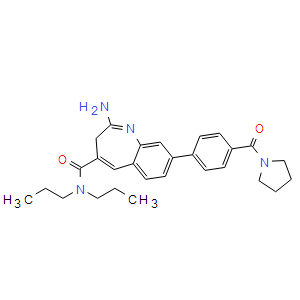| Cas No.: | 926927-61-9 |
| Chemical Name: | 3H-1-Benzazepine-4-carboxamide, 2-amino-N,N-dipropyl-8-[4-(1-pyrrolidinylcarbonyl)phenyl |
| Synonyms: | VTX 2337,VTX2337 |
| SMILES: | N1C2=CC(C3=CC=C(C(N4CCCC4)=O)C=C3)=CC=C2C=C(C(N(CCC)CCC)=O)CC=1N |
| Formula: | C28H34N4O2 |
| M.Wt: | 458.6 |
| Sotrage: | 2 years -20°C Powder, 2 weeks 4°C in DMSO, 6 months -80°C in DMSO |
| Description: | Motolimod is a selective Toll-like receptor 8 (TLR8) agonist, with an EC50 of approximately 100 nM. |
| In Vivo: | Monkeys receive a subcutaneous injection of Motolimod (1 or 10 mg/kg), and plasma is collected predose, 6, 12, 24, and 96 h post-injection. For the 10 mg/kg dose, mean plasma levels of IL-1β increase from baseline levels of 0.5 pg/mL, up to 9.12±2.7 ng/mL (p<0.05, t-test) at 6 h post-administration of Motolimod (10 mg/kg). Circulating levels of IL-18 also increase from a baseline of ~ 1 pg/mL to 68.7±4.4 pg/mL (p<0.05, t-test) at 6 h in response to the Motolimod (VTX-2337) treatment (10 mg/kg). Levels of IL-6 are monitored, as this mediator is induced in response to TLR8 activation, but the release is independent of NLRP3 inflammasome activation. In addition, plasma levels of IFNγ are assessed as a measure of NK cell activation in response to Motolimod treatment[2]. |
| In Vitro: | Among the TLRs tested (TLR2, 3, 4, 5, 7, 8, and 9), Motolimod (VTX-2337) selectively activates TLR8. Motolimod stimulates the production of both TNFα (EC50=140±30 nM based on 10 donors) and IL-12 (EC50=120±30 nM based on 10 donors) in PBMCs. The EC50 value for MIP-1β induction is 60 nM for Motolimod[1]. |

 DC Chemicals' products qualify for U.S. tariff exemptions. We guarantee no price increases due to customs duties and maintain stable supply, continuing to deliver reliable research solutions to our American clients.
DC Chemicals' products qualify for U.S. tariff exemptions. We guarantee no price increases due to customs duties and maintain stable supply, continuing to deliver reliable research solutions to our American clients.





















